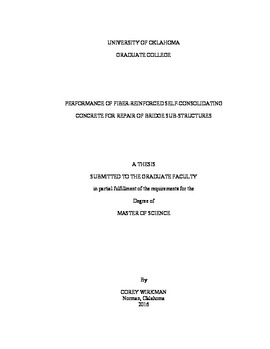| dc.description.abstract | The damage of various reinforced concrete elements accounts for significant annual expenditures by state and federal transportation agencies on bridge maintenance, repair, or replacement. With the rising costs of materials and labor, as well as a demand for faster construction, the development of cheaper and faster alternatives has become a necessity. Concrete types, such as fiber-reinforced self-consolidating concrete (FR-SCC), make large strides towards making these new construction demands a possibility. FR-SCC, for instance, is a high performance concrete characterized by its ability to flow under its own weight eliminating the need for vibration, cutting down on labor costs and speeding up construction.
The main objective of this study was to investigate key engineering and structural properties of bridge substructures retrofitted with fiber-reinforced self-consolidating concrete tension zones. The testing program compared FR-SCC repair mix designs at two different Komponent replacement levels: 10% replacement, denoted as C-10%, and 15% replacement, denoted as C-15%. A standard Oklahoma Department of Transportation (ODOT) Class AA mix was used as a baseline control mix throughout the study. In addition to material properties testing, both small-scale and full-scale repair tests were conducted. The small-scale repair tests included Third Point Loading Composite Prism Tests as well as Bond Strength Tests. The full-scale tests included a total of 9 beam specimens. One set of 3 control beams (C-C), and two sets of 3 repair beams representing either C-10% or C-15%. While the small-scale tests provided a good indicator on how the two concretes were going to interact, the full-scale beams allowed for a more realistic stress state response in evaluating the flexural performance of these repairs.
Overall, the two repair concretes, C-10% and C-15%, examined throughout this study showed comparable load-carrying capacities and cracking loads to the monolithic control beams. In addition, analysis of the fresh concrete material properties indicated that highly workable FR-SCC can be made using synthetic fibers and local materials. The investigated mixtures fulfilled all the passing ability, filling capacity, and stability requirements needed to provide a successful repair. Analysis of the small-scale test results indicated that both C-10% and C-15% fiber-reinforced self-consolidating repair concretes performed comparably to the control ODOT Class AA concrete. In addition, the two sets of FR-SCC repair beams were statistically equivalent to the control beams. They had similar ultimate moments, almost identical load versus deflection plots, and had relatively similar cracking behaviors. | en_US |
